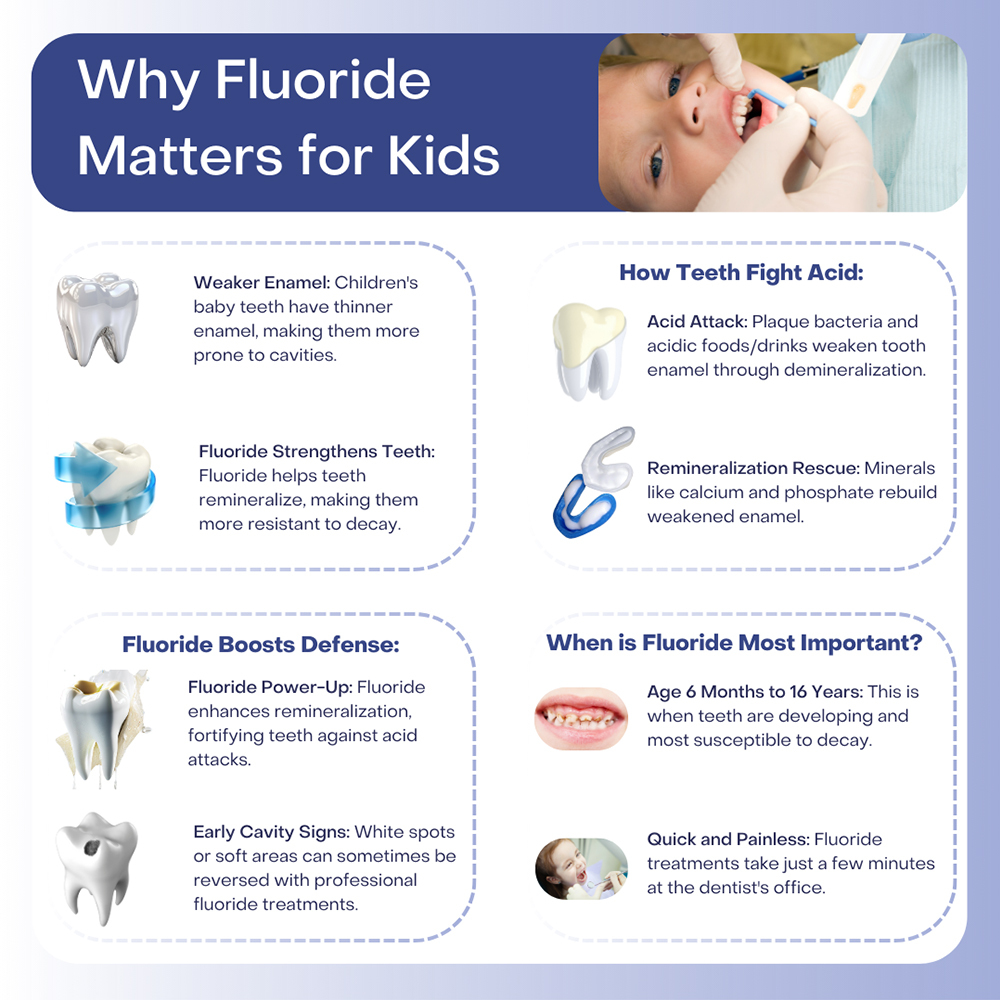Table of contents
We often recommend fluoride treatments for children to help strengthen their tooth enamel. Children’s baby teeth are more vulnerable to tooth decay than adult teeth since their tooth enamel is thinner and more easily eroded. Treatment is also useful for older children and teenagers.
While teeth are covered with tough tooth enamel, the hardest substance in the human body, the enamel can still become eroded and damaged. Each day, your tooth enamel is exposed to acids. These acids are formed by the bacteria found in plaque or are found naturally in certain acidic foods and beverages.
When tooth enamel is exposed to acids, it demineralizes, so some of the minerals in the enamel are removed, leaving it softer and more vulnerable to permanent erosion. When acidity levels begin to normalize, the reverse process begins, which is remineralization. Some of the minerals removed from your tooth enamel remain in your saliva and are redeposited back into the enamel, including calcium and phosphate.
Demineralization and remineralization can occur multiple times each day, every time your child eats or drinks anything sugary or starchy. Repeated exposure to acids eventually weakens tooth enamel, resulting in enamel erosion and the early signs of cavities. Fluoride helps protect teeth by enhancing remineralization, making tooth enamel more resistant to acids.
Early signs of tooth decay, like white spot lesions or soft spots in tooth enamel, can sometimes be reversed with professional fluoride applications at our dental office.
Children between six months and 16 years must receive a certain amount of fluoride while their teeth are still developing. When your child visits us for a dental checkup, we can assess their oral health and determine if they would benefit from a fluoride treatment. Fluoride treatments are quick and painless to apply. A fluoride treatment usually takes five minutes or less to complete.

Before a fluoride treatment, we recommend cleaning your child’s teeth professionally. Removing all plaque and tartar enables the fluoride to penetrate the tooth enamel more effectively. Fluoride can be applied in several ways, including:
Fluoride foam can be dispensed into a mouth tray and gently inserted into your child’s mouth, covering their teeth. They can sit comfortably in the dental chair for several minutes while the fluoride is absorbed topically.
Fluoride gel can be painted directly onto teeth or dispensed into a mouth tray and applied like fluoride foam.
Fluoride varnish is painted directly onto teeth. It then remains in place until your child brushes their teeth before bedtime. It is perfectly safe to eat with fluoride varnish.
Silver diamine fluoride (SDF) is a fluoride treatment that can help prevent cavities from worsening. It is used when a child has tooth decay that may affect their primary or baby teeth, instead of traditional restorative treatment such as a dental filling. It can also help people with special needs.
SDF can cause black staining around the area where it is applied, but it can be extremely effective in halting tooth decay and helping to remineralize tooth enamel. The silver component of SDF helps kill the bacteria responsible for causing cavities.
Before SDF is applied, teeth are dried, and a tiny brush is used to paint SDF onto the cavities before the area is air-dried again. Blue light can help SDF penetrate tooth enamel more deeply.
Your child’s oral health needs are unique. Therefore, when they see a pediatric dentist, we can assess their dental health, determine their risk of cavities, and recommend a suitable treatment plan. Some children may benefit from more frequent fluoride treatments, while others may need them less often.
Generally, SDF is only applied yearly but may be used more frequently if needed.
While fluoride can be harmful if ingested in large quantities, over-the-counter products like toothpaste and mouthwash contain low fluoride levels. Provided they are used correctly, they should be perfectly safe. If you have young children, then we recommend following these guidelines:
My New Jersey Dentist uses professional-strength fluoride products for our treatments. These are stronger than over-the-counter products but are perfectly safe when used by dental professionals.
Dental fluorosis is where white lacy flecks or brown stains can appear on tooth surfaces. These can form even before a child’s teeth erupt and are usually due to drinking unregulated water, such as well water that can contain too much fluoride. Professional fluoride treatments will not cause dental fluorosis.
Public water supplies are tightly regulated and tested to ensure they do not contain too much fluoride. Drinking fluoridated water can be useful because it is absorbed into your teeth and bones when you consume it. Anything that isn’t absorbed is eliminated from your body in your urine.
Fluoride treatments are inexpensive and are most likely covered by dental insurance policies because they are preventive dental care treatments.
Dental fluoride treatments are a safe and cost-effective way to protect a child’s teeth. Treatment is quick and non-invasive; afterward, your child can go about their activities immediately. We may recommend waiting half an hour before they have anything to eat and drink to give the fluoride time to penetrate their tooth enamel more efficiently.

My name is Victoria Kushensky. I am a general dentist dedicated to remaining at the forefront of my field. Combining compassionate care with extensive knowledge, I offer cosmetic and general dentistry services as well as advanced root canal treatments.
I earned my Doctor of Dental Surgery (DDS) degree from the esteemed New York University College of Dentistry. Throughout my career, I have honed my skills in various dental procedures, ensuring effective treatment for each patient’s unique needs. I prioritize patient comfort and understanding, taking the time to thoroughly explain procedures and address any questions.
More about Dr. KushenskyMy NJ Dentist: Victoria Kushensky, DDS
385 Prospect Ave Suite 304
Hackensack, NJ 07601
(201) 298-8000